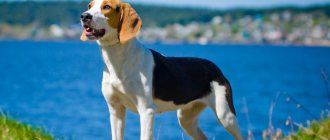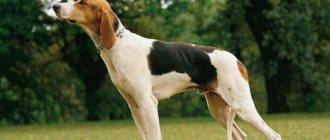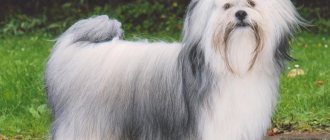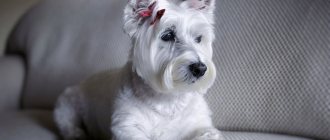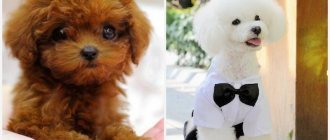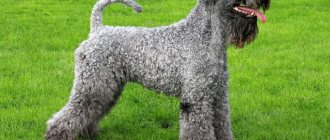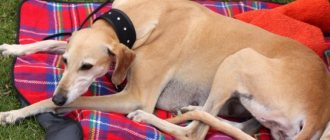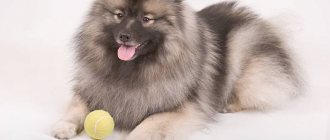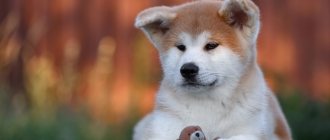"Hello! Tell me, what is the difference between a beagle and an Estonian hound? We want to get one of these dogs, I would like to know which one to choose, and if they have any fundamental differences at all. Thank you! (Nina)"
The breeds are similar to each other because beagles are the ancestors of Estonian hounds.
After a law was passed in Estonia prohibiting the use of dogs taller than 45 cm in hunting (this was done to preserve the roe deer population), breeders began crossing previously used Russian and Anglo-Russian hounds with beagles purchased in England. Additionally, Swiss and Finnish hounds, as well as foxhounds, were used to create a new breed.
The differences between the Estonian hound and the beagle are as follows: the physique of the Estonian hound is slimmer and more elegant (beagles look stocky in comparison), while “Estonians” are noticeably taller - from 42 to 52 cm, while beagles have an average height of withers is 33–40 cm.
There are important differences in the character of dogs. The Estonian Hound is characterized by obedience, it is easier to train and concentrates better on the task at hand. Compared to the beagle, her temperament can be called calm and reserved. This dog tolerates loneliness quite easily and does not need constant attention from humans. Most often he treats other animals with indifference (although this does not exclude the need for socialization). Distrustful and wary of strangers.
Beagles have a lively, extremely playful, friendly and restless disposition. They love to be in the company of people and do not tolerate loneliness well, love active games with their owners, and adore children. They love guests very much, as they are usually friendly towards strangers. For this reason, it is recommended to walk them only on a leash - a stranger can entice them with treats or games.
Such a pet is restless and stubborn, which can make training difficult. It is recommended to conduct training in the form of a game. By the way, if you have a plot of land, please note that representatives of this breed love to dig and can not only ruin the beds, but also dig a hole under the fence to free themselves.
Beagles do not get along well with small animals because they see them as prey. But they are friendly towards other dogs and are always ready to play with them.
The working qualities of these breeds are also important for hunters. Beagles usually work in a pack, their goal is to drive the prey, but the task of the “Estonian” is to lead it to the hunter. Both of them can hunt hares, sometimes wild boars and other animals.
History of the breed
You will be surprised, but the Estonian hound breed appeared not because hunters in its country were given almost complete freedom of action, but, on the contrary, due to the introduction of a law restricting them. Thus, the mentioned resolution implied a state ban on roe deer hunting. In this regard, it was understood that hunters would lose the right to use large dogs in hunting, since these pets could frighten these graceful animals.
The term “big dog” in this case meant all dogs whose height at the withers exceeded 45 centimeters.
In connection with the entry into force of this state decree, canine breeding work began in the 30s of the twentieth century. All representatives of the group of hounds existing at that time began to interbreed with each other. So, at this time the following were purchased in the UK:
- Beagles;
- Foxhounds.
Beagle
Foxhound
These small-sized dogs began to crossbreed with their larger-sized counterparts, such as:
- Swiss Hound;
- Russian hound, etc.
Swiss hound
Russian hound
As a result, as a result of countless crosses, a breed appeared that we know well - the Estonian hound. As you know, it was not suitable for hunting roe deer and could not scare them, so its use was mainly limited to tracking animals such as:
- foxes;
- hares;
- other small forest inhabitants.
The desired breed took the best from its ancestors. She was highly valued for:
- subtle sense of smell;
- greater endurance;
- high activity;
- long lasting energy;
- pronounced hunting instinct.
In addition, unlike the British breeds, which were adapted to the climate of Foggy Albion, it best tolerated the temperate continental weather conditions of its homeland.
Variety in several colors is a feature of the colors of this breed
After the collapse of the Soviet Union, the Estonian Kennel Club became part of the International Canine Federation. The standard of the breed we are considering was agreed upon with this organization back in 1998.
In its homeland, the sought-after breed has maintained its status as the most popular since its breeding to this day. Estonians are especially proud of her energy, although such tough entertainment as hunting has long lost its attractiveness for the residents of this country.
basic information
- Breed name:
Beagle - Country:
UK - Apartment maintenance:
excellent - Lifespan:
12 – 15 years
- Height of males:
36 – 36 cm - Bitches height:
33 – 38 cm - Male weight:
10 – 11 kg - Bitches weight:
9 – 10 kg - Owner experience:
suitable for beginners
The Beagle is a medium-sized hunting dog breed. Beagles are similar in appearance to Foxhounds, but with shorter legs and longer ears. This breed has a good sense of smell, so these dogs are used for hunting hares and for detecting explosives.
Character of the breed
As you can imagine, every hound has a hunting background. In particular, the Estonian representative of this group was used for its intended purpose for many years. You need to understand that his blood, in which flows the legacy of his ancestors who drove animals for many years, determines the following qualities:
- extraordinary intellectual characteristics;
- independence;
- independence.
This breed has an easy-going personality, perfect for beginners.
All this is not surprising, since the hound, in its essence, is an independent hunter, since it was she who had to set the direction of the entire hunting procession, in which there were not only other dogs performing other functions, but also the owner himself - the man. It turns out that the dog was allowed to make its own decisions regarding its future path. This could not but affect her character, as well as the development of quite obvious mental abilities.
Another feature of the Estonian hound is aggression towards forest animals. By the way, sometimes because of this instinct, hounds have big problems in coexistence with smaller pets of their owners, for example, with:
- cats;
- rabbits;
- and even more so with domesticated foxes, raccoons, etc.
This dog treats humans with love and great devotion.
Nevertheless, with regard to communication with a person, all the standard manifestations of predisposition take place here:
- Love;
- devotion;
- affectionateness;
- tenderness, etc.
For the Estonian hound, the owner is the main love and meaning of life. Any order with proper training will be carried out by the dog with aspiration, because its only desire is to serve the person.
However, despite their independence and willfulness, these animals are very trainable. In principle, any owner, with the right approach, can, without the help of professionals, raise this dog in such a way that it obeys unquestioningly. However, even if you go to the dog handlers, there is one very acute moment in dealing with a hound: provided that you let it off the leash on the street, it can unexpectedly pick up the scent of some game and run away without even hearing the screams of the owner or his orders. This is because the hunting instinct will simply drown out all other thoughts.
Unfortunately, the disadvantages of the hound include loud barking. However, this problem can be worked out very well with a dog handler.
In addition, potential hound owners also need to keep in mind that these dogs bark very, very loudly, and can do this non-stop. Unfortunately, barking was previously necessary for this breed, because it had to scare the forest game to horror. Now the loud cries of the animal only interfere. However, they can be controlled if you teach the dog various commands, which is necessary to do if the dog is going to live with you not in a private house, but in a city apartment.
Character, abilities, skills
Estonian hounds are considered one of the smartest hounds. They lend themselves very well to training and education, are not willful (although sometimes they show stubbornness), and there is no excessive curiosity. When hunting they are passionate, angry towards the animal, persistent in searching and unraveling traces, but at home they will be calm and balanced.
Representatives of the breed have an excellent sense of smell and developed hunting instincts. Thanks to their small stature, they can crawl under spruce and dead wood, where animals can hide.
They swim well, even without training.
Breed standard
The standard of this breed implies a set of exterior features of a given dog that distinguishes it from other representatives of the canine family, as well as from its immediate relatives - members of the hound group.
Like any other officially recognized breed, the Estonian Hound has its own standards.
Table 1. Estonian Hound breed standard
| Exterior element | Description |
| Body | This dog is of average height, and its body is very strong, muscular and dry. The height of this animal at the withers is:
|
| Wool | The color of these representatives of hounds usually corresponds to the standard for the group of breeds in question as a whole: black and piebald, decorated with so-called ruddy spots. The sizes of these spots are not specified by the standard, therefore, they can have any size. In some situations, dogs may exhibit pronounced markings, which is considered not a fault of the breed, but a defect. The coat itself is short, shiny, and hard and smooth. It is especially thick on the tail, so it seems that these animals have a thick tail. |
| Head and neck | The head of representatives of this breed is wide and has a rounded shape. The muzzle is elongated, ending with lips that fit tightly to the jaw and a wide nose of black or dark brown color. The ears of these hounds are hanging, elongated, but have a small thickness. Their landing is low. The ears are covered with short hair. The eyes of the Estonian hound variety are set askew and have a dark brown tint. The neck of Estonian hounds is strong, muscular, and has a rounded shape. |
| Limbs | The front and hind legs of these dogs are very muscular, located parallel to each other and have a straight shape. At the same time, the elbows look back. The paw pads are wide, fleshy, oval-shaped and have tightly clenched toes. The tail of Estonian hounds has the shape of a saber, thickened at the base and gradually becoming narrower towards the tip. |
The Estonian Hound has a saber-shaped tail
Differences between dogs by coat color
The differences between the Estonian hound and the beagle are quite difficult to determine by their color, since from the outside they do not seem so different. Classic beagles have white fur with black and red spots. The dog can also have a red and white color, badger, white and lemon with red or red splashes. The tip of the animal's tail should be white, regardless of the main color of the coat. Hounds are mostly black and piebald with pronounced ruddy spots. The coat can also have a white background with black, yellow, and red areas. The dog's paws and tail are white.
How to choose a puppy
The breed we are considering is widespread not only in its homeland, but throughout the world, in particular also in Russia, therefore, acquiring it is not at all difficult. It is best to contact a nursery that specializes in breeding these breeds to fulfill your idea. The minimum price for representatives of this breed is 13-15 thousand rubles, however, if you are applying to buy a puppy from champion parents with a pedigree and documents, you will have to pay a slightly higher amount.
Estonian hound puppy
However, despite the fact that trust in the nursery is a priori higher than in private breeders, you can still buy a sick puppy, therefore, it would be best for you to learn how to identify a healthy individual in advance. Here are some rules to follow when choosing a future family member.
- You can pick up a puppy from its mother no earlier than when it is 1 month old. At this age, kids are already quite independent. If you are offered to give your baby away early, do not agree, because this is very harmful to his health.
- The baby's coat should immediately shine.
If the fur is faded, unsightly, or falling out in chunks, then this puppy is sick, and unless you want to cure it yourself, it is better not to adopt it. Wool can say a lot about the health of a particular individual. - Documents are another important detail. Firstly, by this age the puppies should already have all the necessary vaccinations, and secondly, if the puppy was advertised to you as a descendant of blue-blooded parents, you must be shown the appropriate pedigree.
- Carefully examine the puppies for the following:
- limping;
- constant biting of oneself;
- constant squeaking;
- excessive apathy;
- other manifestations that are quite difficult to assign to a healthy individual.
If you find any of these manifestations, it is better to pay attention to another individual. Provided that the chosen baby, on the contrary, meets all your requirements, and the price suits you in all respects, you can buy it without fear.
Choose an active puppy
Posts 1 page 20 of 153
Share128.02.2011 02:12:06
- Author: Besen-ok Biglyonysh From: Moscow Registered: 02/19/2011 Messages: 98 Gender: Female Age: 29 [1989-07-14] Beagle's nickname and date of birth: Bas-Ton, 12/13/2010 Last visit: 05/03/2013 15 :27:51
When viewing different topics, the following question arose: is it possible to somehow distinguish a beagle puppy from an Estonian hound? And is there any difference in the behavior of these breeds?
Share228.02.2011 02:41:45
- Author: VEGA Nursery "Astravegas" From: Sergiev Posad ASTRAVEGAS Registered: 05/09/2007 Messages: 6531 Gender: Female Age: 44 [1974-08-31] ICQ: 392214217 Last visit: 06/19/2019 11:55:50
Is it possible to somehow distinguish a beagle puppy from an Estonian hound?
A professional can most likely do it. Another way is to ask the breeder what kind of puppies he has. Look at the parents and read what is written in the documents.
Share328.02.2011 19:12:26
- Author: Besen-ok Biglyonysh From: Moscow Registered: 02/19/2011 Messages: 98 Gender: Female Age: 29 [1989-07-14] Beagle's nickname and date of birth: Bas-Ton, 12/13/2010 Last visit: 05/03/2013 15 :27:51
A professional can most likely do it. Another way is to ask the breeder what kind of puppies he has. Look at the parents and read what is written in the documents.
According to the documents we are beagles, according to our parents we are beagles. But in the photos I look and see either a beagle or an EG (((I guess like that every day)))
Share428.02.2011 21:05:00
- Author: Vita+Linda Top-beagle From: Moscow Registered: 02/17/2010 Messages: 12515 Beagle's nickname and date of birth: Vita 08/05/2009, Linda 04/25/2010 Website: https://www. videolog. ru Last visit: 01/03/2018 23:00:52
Besen-ok , who are the parents? Well, a fresh photo would be nice. At a very young age, puppies are practically indistinguishable; the difference becomes apparent as the baby grows. Look at the Beagle standard and the EG standard, try to compare with your puppy. Although there are sometimes “Estonian-like” beagles, these are usually breeding shortcomings.
Share528.02.2011 21:12:40
- Author: Lelya Top-beagle From: Krasnoyarsk - Moscow Registered: 01/12/2008 Messages: 4067 Gender: Female ICQ: 409763405 Beagle's nickname and date of birth: SS KALINA 04/23/08, SS HOT LADY 11/23/09, SS JASMINE 08/08/12 Last visit: 10/18/2017 12:02:07
Besen-ok , write your parents' nicknames.
Share628.02.2011 22:00:34
- Author: VEGA Nursery "Astravegas" From: Sergiev Posad ASTRAVEGAS Registered: 05/09/2007 Messages: 6531 Gender: Female Age: 44 [1974-08-31] ICQ: 392214217 Last visit: 06/19/2019 11:55:50
These are usually breeding disadvantages
Exactly, why immediately classify all the simple beagles as another breed? Besen-ok , you didn’t take the dog for exhibitions and breeding, did you? So does it matter what she looks like?
Share728.02.2011 22:02:26
- Author: VEGA Nursery "Astravegas" From: Sergiev Posad ASTRAVEGAS Registered: 05/09/2007 Messages: 6531 Gender: Female Age: 44 [1974-08-31] ICQ: 392214217 Last visit: 06/19/2019 11:55:50
Lelya , I already asked about my parents
I can’t exactly name the parents now, the father is imported from Poland (Peter from some Lozu), the mother is Moscow nickname Reiga, our breeder is Suvorova.
Share828.02.2011 22:08:10
- Author: Lelya Top-beagle From: Krasnoyarsk - Moscow Registered: 01/12/2008 Messages: 4067 Gender: Female ICQ: 409763405 Beagle's nickname and date of birth: SS KALINA 04/23/08, SS HOT LADY 11/23/09, SS JASMINE 08/08/12 Last visit: 10/18/2017 12:02:07
VEGA , I haven’t seen any nicknames.
Share928.02.2011 22:17:45
- Author: VEGA Nursery "Astravegas" From: Sergiev Posad ASTRAVEGAS Registered: 05/09/2007 Messages: 6531 Gender: Female Age: 44 [1974-08-31] ICQ: 392214217 Last visit: 06/19/2019 11:55:50
Lelya , this was in another topic. I’m also hearing these nicknames for the first time. Maybe someone knows? If the dog is imported and used for breeding, someone should know him; he probably went to exhibitions. Besen-ok , do you remember what organization your puppy is from? SKOR, RKF, DM. Did you see the parents when the puppy was taken away? Were they beautiful?
Share1028.02.2011 22:59:03
- Author: Ivolga Biglik From: Moscow, Timiryazevskaya Registered: 03/28/2008 Messages: 470 Gender: Female Age: 51 [1968-02-12] Last visit: 06/05/2016 12:03:28
Beagle and Estonian hound puppies are difficult to recognize for non-professionals, as mentioned above. They are the same funny, fat-bottomed toddlers, especially up to 2 months. This is what some people use. Ah, it's not difficult to deceive me. I'm happy to be deceived myself! (c) Therefore, if you really want a 100% purebred beagle, you need to buy it from breeders who have proven themselves in their business. If you have doubts or have questions about the health or breed of the puppy, and you are being fed ridiculous excuses, do not rush to grab the baby and give money, think, read the information. So you took the puppy in your arms and he began to lick you, it immediately seems to you that he chose you and that’s all. They all lick themselves (in secret). You just need to use your brain and understand why you need a dog in the first place.
Exactly, why immediately classify all the simple beagles as another breed?
VEGA , thank you +10000000 I kept thinking about how to write this so as not to offend. And lately it turns out that if it’s not a beagle, it means an Estonian hound
. What about his relatives, since he’s mongrel, that means he’s a mongrel.
Share1101.03.2011 00:07:04
- Author: Besen-ok Biglyonysh From: Moscow Registered: 02/19/2011 Messages: 98 Gender: Female Age: 29 [1989-07-14] Beagle's nickname and date of birth: Bas-Ton, 12/13/2010 Last visit: 05/03/2013 15 :27:51
Unfortunately, I won’t be able to answer these questions now either, since our documents are being processed for pedigree registration, and they should be picked up in a few weeks. Regarding the puppy’s standard and weight, now it’s difficult for me to evaluate him, he lost a lot of weight during the week he was sick ((((I didn’t see his mother, they explained to us that she was now at the dacha, they showed us photographs. My little pig , in any case, I won’t give it away anywhere, I love him to madness, they took him for hunting. Of course, I don’t want to become a victim of deception, and in the EG I am embarrassed by their disproportion (((Beagles are cuter, but this won’t make us love ours any less. Photo I’ll try to find him now, since I haven’t been able to take a photo of him for the last couple of days, my camera doesn’t catch his hyperactivity)))
Share1201.03.2011 00:13:02
- Author: Besen-ok Biglyonysh From: Moscow Registered: 02/19/2011 Messages: 98 Gender: Female Age: 29 [1989-07-14] Beagle's nickname and date of birth: Bas-Ton, 12/13/2010 Last visit: 05/03/2013 15 :27:51
These are the latest, nothing else has happened since this weekend (((
I understand that little can be said from these photos ((((
Share1301.03.2011 00:15:53
- Author: Ivolga Biglik From: Moscow, Timiryazevskaya Registered: 03/28/2008 Messages: 470 Gender: Female Age: 51 [1968-02-12] Last visit: 06/05/2016 12:03:28
Unfortunately, I won’t be able to answer these questions now either, since our documents are being processed for pedigree registration, and they should be picked up in a few weeks.
Where did you give it to and where to pick it up from?
I didn’t see my mother, they explained to us that she was now at the dacha, they showed us photographs.
This should alert potential buyers
And in the EG I am confused by their disproportionality
This is in vain, it means you haven’t seen the best representatives or are confusing them with someone else.
But this will not make us love ours any less.
But this is the most important thing.
Share1401.03.2011 00:18:50
- Author: Besen-ok Biglyonysh From: Moscow Registered: 02/19/2011 Messages: 98 Gender: Female Age: 29 [1989-07-14] Beagle's nickname and date of birth: Bas-Ton, 12/13/2010 Last visit: 05/03/2013 15 :27:51
Where did you give it to and where to pick it up from?
The documents were handed over to the veterinarian at the Prometheus Stars Club.
This is in vain, it means you haven’t seen the best representatives or are confusing them with someone else.
Before adopting a puppy, we thought for a long time about EG or Beagle, we decided on Beagle, he is shorter and has a prettier face.
Share1501.03.2011 00:28:12
- Author: Ivolga Biglik From: Moscow, Timiryazevskaya Registered: 03/28/2008 Messages: 470 Gender: Female Age: 51 [1968-02-12] Last visit: 06/05/2016 12:03:28
Besen-ok , Here are the EG puppies for comparison, just over 1 month old. Look for differences.
Share1601.03.2011 00:33:05
- Author: Besen-ok Biglyonysh From: Moscow Registered: 02/19/2011 Messages: 98 Gender: Female Age: 29 [1989-07-14] Beagle's nickname and date of birth: Bas-Ton, 12/13/2010 Last visit: 05/03/2013 15 :27:51
I've been looking for weeks now, the only thing I've found is that our ears are larger and round, but EG's ears seem to be pointed, or not all of them?
Share1701.03.2011 00:34:13
- Author: Besen-ok Biglyonysh From: Moscow Registered: 02/19/2011 Messages: 98 Gender: Female Age: 29 [1989-07-14] Beagle's nickname and date of birth: Bas-Ton, 12/13/2010 Last visit: 05/03/2013 15 :27:51
And our white cap on the tail is not so large, the black one predominates. I'm confused. ))
Share1801.03.2011 00:40:33
- Author: Ivolga Biglik From: Moscow, Timiryazevskaya Registered: 03/28/2008 Messages: 470 Gender: Female Age: 51 [1968-02-12] Last visit: 06/05/2016 12:03:28
The documents were handed over to the veterinarian at the Prometheus Stars Club.
Hello, on December 10, 2010 at 10 pm I purchased a Jack Russell Terrier puppy from the breeder Surinova (Surikova) Olga, I am writing a double surname because the n or k in her surname is not clear from her handwriting. Her phone number 8-985-992-86-72 may be suitable for her husband. They live at the address: Moscow, Bestuzhev str., 3. They belong to the canine kennel STAR OF PROMETHEUS. For the first three days, the puppy was very active, played and enjoyed life, the only thing I noticed was that he ate poorly and hiccupped often, I called the breeder, she said that this is normal and there is no need to go to the veterinarian, just watch him and that’s all. On December 14, 2010, the puppy became suddenly ill, stopped eating and drinking, and his temperature rose to 41. He lay there all the time. I immediately ran to the veterinarian and gave him IV injections and everything else, but no matter how hard I tried to save him, I couldn’t save him. On December 18, 2010, the puppy unfortunately died from parvovirus enteritis. I have a doctor’s conclusion that the puppy was already sick at the time of sale, I have his veterinary passport and the puppy’s birth certificate with kennel stamps. The breeder stands her ground and claims that the puppy was healthy, and is not going to return the money. If anyone knows, tell me whether it makes sense to sue her with such a set of documents or if this is not enough. there is a great desire and desire to punish these cruel people who are only interested in the financial side of the issue. Address of the PROMETHEUS STARS club, Moscow, Krasnobogatyrskaya str., 2, building 2
Keeping Estonian hounds
Like any other hunting breed, hounds require constant exposure to fresh air, as well as a lot of physical activity. That is why it is best to purchase them when you have a country house. However, due to their small size, dogs of this breed will get along well in an apartment of any size, however, in this case they will require regular walks:
- 2 or 3 times a day;
- Each walk should be at least one and a half hours.
By the way, before you bring a puppy into your home, you will need to gather your strength and throw out all strong-smelling products from your home, for example:
- perfume;
- freshener sprays;
- aroma oils;
- scented candles, etc.
The fact is that the hunting scent of these animals is so sensitive that the dog faces a lot of suffering if it lives in the house of those who adore strong odors.
The Estonian Hound can become your best friend
Under no circumstances should you bring an Estonian hound into an apartment where small forest animals and other similar animals live, such as:
- fox;
- raccoons;
- rabbits;
- mini pigs;
- lemmings, etc.
In addition, owners of farm poultry, as well as owners of cats, also need to be wary. All these animals are not friends for Estonian hounds, but only prey, and if you do not want to part with them, allowing them to die in terrible suffering, it is better to consider a breed variety for a friend.
The Estonian hound has hunting in its blood
Advantages and disadvantages of the Estonian hound
Advantages:
- He has a loyal and affectionate disposition.
- Calm and balanced.
- Smart and trainable.
- Treats children well.
- Not aggressive towards strangers.
- Strong and resilient.
- With proper training, it becomes an excellent working dog.
- Caring for her is not difficult.
- Undemanding to feed.
- Rarely gets sick.
Flaws:
- Can be aggressive towards other animals.
- Knows how to manipulate masters.
- It is not recommended to trust her training to children.
- To receive an exhibition diploma, the dog must pass field tests.
- Needs a lot of physical activity.
- Can get carried away in pursuit of prey, run away and get lost.
When Estonian hounds are kept and bred in urban conditions, these dogs lose their hunting skills and turn into ordinary companion dogs..
Caring for Estonian hounds
The animals of the breed we are considering are very unpretentious creatures. Therefore, the list of procedures that need to be carried out to care for them is not so long.
- The first item on the list of grooming procedures for Estonian hounds is brushing. Yes, even though their coat is smooth, they still require brushing to maintain their good appearance. Fortunately, for combing in this case, it is enough to buy a special glove-brush, with which you will not only remove the fallen hair from the dog’s body, but also perform a kind of skin massage, which will have a very beneficial effect on the appearance and health of the animal.
- The second point is washing, which in the case of the breed we are interested in is carried out only when necessary.
Estonian hounds are washed as needed. - The third point is cleaning the ears from accumulated dirt in them to prevent the development of demodicosis and other diseases. It is carried out using a cotton swab and a special oil solution, which can be purchased at a veterinary store.
How often to clean your dog's ears
Training
Representatives of the breed we are interested in literally grasp all commands on the fly, mainly because they do not want to obey the owner, and easily make contact. As we said above, owners can effectively train Estonian hounds without the help of a dog handler, on their own, having previously studied some relevant literature.
It is very important to remember two rules for successful training:
- early socialization of the dog;
- no corporal punishment or yelling.
You can handle the training yourself, but you can entrust the training of your dog to professionals
These animals will be more flexible the sooner you bring them into the world and begin training. Everything is simple with this, but it can be difficult for the owners to resist beatings. When you hear the word beatings, you should not imagine kicks; in this category, once and for all, you should include such concepts as:
- flip flops;
- pinching;
- twitching of the tail, paws, ears, etc.
However, if you don’t have the time, energy, or considerations for training, then pack up your dog and yourself and go to classes with a dog handler. It would be better to raise a hound, since it is not a decorative dog.
These animals need to be socialized as early as childhood.
Personality differences
The most important aspects of choice: character traits. If the Baltic beagle is characterized by complaisance and demonstrative obedience, then the English aristocratic relative is capricious, eccentric and disgustingly stubborn.
Estonian hounds are easier to train and train; they have no problems with concentration and motivation. Baltic greyhounds are less independent, they are more owner-oriented, and more “modest” with feelings and emotions. The Estonian Hound's temperament is calm and self-possessed. This is something between a sanguine person and a phlegmatic person.
Beagles are the canonical Energizers. Beagles are classic choleric dogs: wild energy and a tireless thirst for activity do not leave English hounds from early childhood to old age. Raising and training beagles is hard work. Smart and quick-witted dogs “grab everything on the fly,” and the problem arises at the stage of diligence and obedience.
Nutrition of Estonian hounds
In order for your pet to develop properly, you need to approach its diet wisely. If you are a supporter of natural food for animals, then you definitely need to create a dog menu according to the recommendations presented in the table below.
Table 2. Diet of the Estonian hound on a natural diet
| Food category | Percent |
The first and necessary category of food for hounds is proteins. Your dog can get them from foods such as:
| The percentage of protein food in the hounds' diet should be approximately 70% |
It is imperative to give dogs vegetables and other plant foods, since fiber is necessary for the normal functioning of their intestines, in addition, they contain a large amount of vitamins. Among plant foods, the most preferred for hounds are:
| The percentage of fiber content in a hound's diet should be approximately 10% |
| In addition, dogs should also receive carbohydrate foods, which, just like people, give these animals energy for life, training and other activities. So, cereals, preferably buckwheat or rice, can be included in this category. | The percentage of carbohydrates in the hounds' diet should be approximately 20% |
The more properly you feed your dog, the healthier it is.
If you prefer to feed your dogs industrial food, then your choice is food from the “holistic” and “super-premium” categories. They are initially balanced according to the percentage indicated in the table, and are also saturated with vitamins and various microelements that are necessary for the proper functioning of the animal’s body.
Love your pet and he will love you back
Care and maintenance
Estonian hounds are quite unpretentious, which allows them to be kept in city apartments. They practically do not shed and do not require regular brushing: it is enough to sometimes comb them with a special bristly glove before bathing.
What to feed your Estonian hound? They eat both ready-made food (not lower than premium class) and natural food. The diet should include vegetables, fruits, and definitely meat and fish. Eggs and fermented milk products will be useful as a treat.
Because of their activity, they need a lot of walks and active games, otherwise they can begin to destroy the situation, splashing out the accumulated energy. Easy to train, good at contact.
A dog taken out into the wild must be protected from tick bites, carriers of various infections. Droopy ears can cause otitis media. Hunting dogs are susceptible to arthritis and arthrosis due to the high load on the joints.
With good care and care, they live an average of about 12 years. They retain their energy even in old age.
A tale of two breeds
Both breeds are classified as hunting dogs and scent hounds. The Beagle is the oldest breed, which was discovered in Great Britain in the 15th-16th centuries. According to legends, dogs were brought to the country by the Romans, who took these hounds from the Greeks. Dogs were bred to help track hares and other large rodents during hunting. The breed itself was officially presented to the whole world in 1880. It was then that the first nurseries and clubs for breeding beagles appeared. However, since then they began to be bred as an ornamental and family breed. The wide distribution of these dogs began after the end of World War II.
If beagles were raised and developed naturally, without the use of forced selection, then the Estonian hound had to undergo some changes. At the beginning of the twentieth century, Estonia extended a ban on hunting with hounds whose height was higher than 45 cm. This decree was created in order to provide protection to the then endangered roe deer. Therefore, the hunters began to look for a way out of this situation.
Who is better to have
A comparison between the Estonian hound and the beagle is impossible without the purpose for which the dog is bred.
If you need a companion, a family pet, or just an optimistic friend, it’s better to get a beagle. Plus, its size is smaller than that of the “Estonian”, making it easier to keep a pet in an apartment. The Estonian Hound is a serious hunting dog. Non-hunters are not advised to own one. Temperament, the desire to track and drive animals are the key differences of the breed.
Without work, “Estonians” are withering away. Often, after a year or two, inexperienced owners are looking for someone to give their pet to. It is difficult to part with a pet, but it is even more difficult to find a hunter who wants to take an adult, untrained dog.
Moreover, you need to remember that English beagles and Estonian hounds are not easy to train. If you can’t make circles in fields and forests for 3-4 hours every day, you should take a closer look at calmer dogs.
External differences between dogs
It is very difficult for people who do not understand these two breeds to find the differences between the Estonian hound and the beagle, since the dogs are really similar to each other. However, their exterior data differs. Although not everyone can identify these differences.
According to the RKF breed standard, the beagle is a smooth-haired, small but strong dog of a tricolor color. The dog has an elongated body, a long back and a short loin. His chest is very low. It goes down much lower than the elbows. The beagle's belly is neatly tucked and its neck is long and arched. The dog's limbs are straight, parallel to each other, located under the body and are particularly muscular. The paws are round and the claws are short.
The Estonian Hound is a hunting dog with a larger body and coarse hair. Her body is longer than that of a beagle, and her withers are sloping and protruding. The dog's back is straight, the chest does not fall below the elbows, and the stomach is always slightly retracted. Her limbs, unlike the muscular legs of the beagle, have a dry and bony appearance. The elbows are pressed tightly to the body. The paws are oval-shaped and the claws are quite large, compared to the small claws of the Beagle. The weight of the Estonian Hound ranges from 12 to 25 kg.
The dog's tail resembles a saber as it reaches the hock area. The tail set is medium, so an excited dog will not be able to raise it above the level of the back. Since the Estonian Hound's coat is very hard and thick, it appears thick and large in appearance. The beagle has a tail of medium size and length, straight and without a break. Just like the Estonian hound, it is densely covered with hair. Beagle weight varies from 10 to 18 kg.
The main differences between the Estonian hound and the beagle
The breeds are similar to each other because beagles are the ancestors of Estonian hounds.
After a law was passed in Estonia prohibiting the use of dogs taller than 45 cm in hunting (this was done to preserve the roe deer population), breeders began crossing previously used Russian and Anglo-Russian hounds with beagles purchased in England. Additionally, Swiss and Finnish hounds, as well as foxhounds, were used to create a new breed.
The differences between the Estonian hound and the beagle are as follows: the physique of the Estonian hound is slimmer and more elegant (beagles look stocky in comparison), while “Estonians” are noticeably taller - from 42 to 52 cm, while beagles have an average height of withers is 33–40 cm.
There are important differences in the character of dogs. The Estonian Hound is characterized by obedience, it is easier to train and concentrates better on the task at hand. Compared to the beagle, her temperament can be called calm and reserved. This dog tolerates loneliness quite easily and does not need constant attention from humans. Most often he treats other animals with indifference (although this does not exclude the need for socialization). Distrustful and wary of strangers.
Beagles have a lively, extremely playful, friendly and restless disposition. They love to be in the company of people and do not tolerate loneliness well, love active games with their owners, and adore children. They love guests very much, as they are usually friendly towards strangers. For this reason, it is recommended to walk them only on a leash - a stranger can entice them with treats or games.
Such a pet is restless and stubborn, which can make training difficult. It is recommended to conduct training in the form of a game. By the way, if you have a plot of land, please note that representatives of this breed love to dig and can not only ruin the beds, but also dig a hole under the fence to free themselves.
Beagles do not get along well with small animals because they see them as prey. But they are friendly towards other dogs and are always ready to play with them.
The working qualities of these breeds are also important for hunters. Beagles usually work in a pack, their goal is to drive the prey, but the task of the “Estonian” is to lead it to the hunter. Both of them can hunt hares, sometimes wild boars and other animals.
Difference in character
Reviews from owners about the Estonian hound confirm that the character of this dog is strikingly different from the character of its fellow beagle. The breeds are very similar in temperament, as both are very agile and active. However, beagles are more friendly, energetic and curious. The Estonian Hound is much calmer and more balanced.
While the Beagle will be friendly to all passers-by and family friends, the Estonian Hound will remain neutral, giving its love and loyalty only to its owner and his family members. Beagles look like real Energizers. They try to get in everywhere, attract attention and want to make contact with every living creature in the area. This is the whole character of the beagle. The description of the Estonian Hound breed is completely opposite. This dog behaves with restraint, intelligence and respects subordination, subject to good upbringing. She also vitally needs human attention, but she does not demand it and does not impose it.
This dog owes its character to careful selective work carried out many years ago. Even after a lot of time, she remained an intelligent working hound, able to perform her duties and hunt well. Beagles are more suitable for the role of a pet. The nature of the breed contributes to this. It is impossible to describe beagles without mentioning their charm. It is limitless, and therefore dogs feel great as companion dogs. Of course, their hunting reflexes are developed at the genetic level, but in comparison with Estonian hounds they are significantly inferior in their expression.
Character and temperament
The Estonian is a passionate hunter with a sharp mind. It is noteworthy that malice towards the animal manifests itself only during the hunt, but at home it is an affectionate, calm and gentle favorite. She is ready to carry out the owner’s orders and approaches a person at the first call.
Pros:
- spiteful towards the beast;
- starts working early;
- capable of persistently pursuing an animal while hunting;
- devoted;
- good-natured and affectionate;
- energetic;
- obedient;
- brave.
Minuses:
- prone to hyperactivity;
- sad without work;
- easily picks up the animal's trail and runs away if he walks without a leash.
Attitude towards children and family
The differences between the Estonian hound and the beagle can also be determined by the dogs’ attitude towards family members. Beagles trust everyone. They rejoice at everyone who reciprocates their feelings. Greyhounds from Estonia are more picky and careful in their choice. They always single out one owner for themselves. They will only obey him unquestioningly, but they may ignore the instructions of other family members. The Beagle also gets along better with children. A dog of this breed will be an irrepressible, active and cheerful friend for them, who is always ready to actively play and enjoy life. The dog can chase the little one around the yard for hours and entertain her with his ringing bark.
Based on the description of the Estonian Hound breed, it will not show the same enthusiasm towards a child. This dog always understands that its main task is to hunt, and not to have fun on the lawn. Of course, she will not behave aggressively with children. The hound will never offend them or bite them, but it will also play in rare cases, if the mood is appropriate.
Despite the friendliness and love of games, beagles should not be left alone with such a dog. The dog may start playing and then knock the baby down or accidentally push him.
Pet character
The Beagle is a friendly, sociable and cheerful dog. He is energetic, active and inquisitive: he will never miss a chance to go in search of adventure, which is why it is recommended to always take him for a walk only on a leash.
CAREFULLY!
This is an intelligent animal, but the process of training it may not be the easiest due to its inherent stubbornness and inability to focus for a long time on the commands it is learning.
Beagles treat all family members well. They get along well with other animals and children and do not show aggression towards strangers.
With proper upbringing and training, a beagle makes a wonderful companion: smart, loyal and affectionate..
Dogs' attitude towards strangers
Comparisons between the Estonian Hound and the Beagle are easy to make on the street. During a walk, the differences between these dogs appear very clearly. The beagle will happily wag its tail at every passerby. He runs up to all people, animals and children without fear. He craves attention and simply loves when it is given to him. A dog of this breed will undoubtedly go for any treat or toy that is lured to it. That is why beagles need to be trained from puppyhood so that they react as little as possible to passers-by and follow the owner’s commands. Such a dog is quite easy to steal because of his gullibility and thirst for communication. Therefore, you should not let your beagle off the leash in crowded places.
The difference between the Beagle and the Estonian Hound lies in the innate intelligence of the latter. The Hound is guided by manners and is therefore very calm and alert. A dog of this breed will never run towards anything living or interfere with passers-by. There is nothing a stranger can do to attract or interest her. No treat or toy can cloud her mind. Many people love this breed precisely for its innate sense of caution and restraint.
Who should you choose?
In this case, it would be reasonable to proceed from the purposes for which the dog is purchased.
If you only need a companion, then it is better to choose a beagle, because it is smaller in size, and besides, at present, most lines of this breed have become more decorative than working.
The most popular breed varieties of beagles:
If we are talking about purchasing a future hunting assistant, then it is better to choose the Estonian hound, since this breed is still a working breed, which is confirmed by admission to breeding only after successfully passing field tests.
The Beagle and the Estonian Hound are breeds that are similar not only in appearance, but also related in origin.
It was the beagle that “gave” the Estonian hound strong and strong paws and a loud, booming voice.
At present, the Estonian hound has remained mainly a working dog and has retained all its hunting qualities..
The Beagle is now more likely to be just a companion dog than a hunting dog. And, although there are still working lines of this breed, most modern dogs of this breed are simply pets: faithful, devoted and loving to their owners.
Dog training ability
The Estonian Hound responds very well to training if done as early as possible. From about two to three months, it is necessary to gradually begin teaching commands, increasing the intensity of training based on age. The dog has good perseverance and memory. She quickly remembers all the commands and is great at demonstrating them. The Estonian Hound loves to learn, but hunting skills will take quite a long time to develop, practicing them in practice. Therefore, if using a dog for hunting is not a priority, it is better not to fill the dog’s head with unnecessary knowledge.
Beagles, unlike Estonian hounds, are very restless. It will be difficult to teach them commands, since the dog does not like to sit still. She constantly runs, jumps, plays and tries to provoke her owner into action. To train a beagle well, you will need a lot of patience. If the owner does not have it, it is better to leave it to the dog handler. If you neglect to train your dog, it will become uncontrollable both at home and on the street.
Dogs and other pets
Both breeds perceive other pets only as prey. Therefore, it is not advisable to get another animal. They will chase any cat, hamster, or parrot and dream of killing it as a victim. The only difference between the two dogs is that a beagle can be trained to be wary of another type of animal, while a hound cannot. If a beagle lives in the same room with a cat from birth, then he will be able to imagine her not as prey, but as a friend. The Estonian hound, even in puppyhood, will hunt for any small animals, since its instincts are more developed than those of the beagle.
